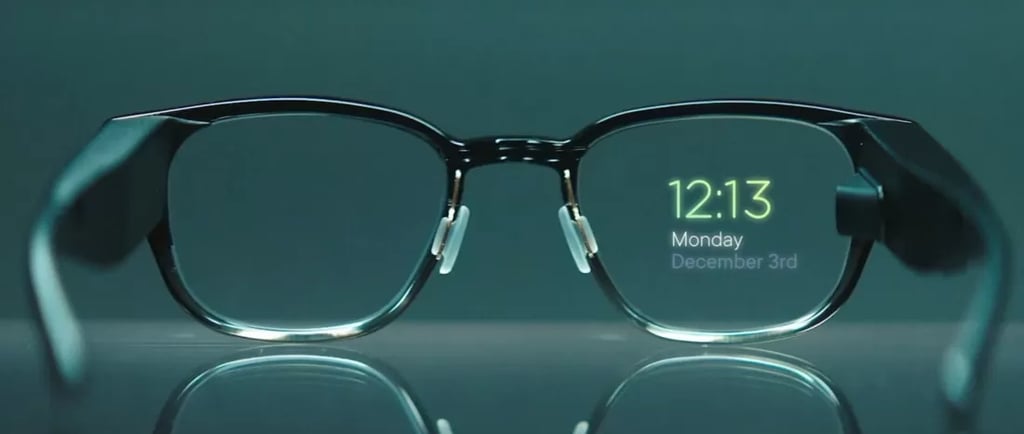items chosen one by one so you have the best option and save money on amazon (Links in articles)
Smart Glasses 2.0: How AR Eyewear Is Replacing Your Phone in 2025
Imagine checking your messages, navigating the city, and even taking a video call — all without ever pulling your phone out of your pocket. That’s not science fiction anymore. In 2025, Smart Glasses 2.0 are here — and they’re not just wearable tech novelties. They’re fully functional, AI-powered AR headsets, compact enough to look like everyday eyewear, yet powerful enough to start replacing your smartphone. Major tech giants and startups alike are racing to dominate this space — and users are already experiencing the next frontier in personal computing, literally right before their eyes. Let’s explore how this disruptive technology is reshaping communication, productivity, entertainment, and mobile life.
5/15/20253 min leer


👓 What Are Smart Glasses 2.0?
Smart Glasses 2.0 are the next generation of augmented reality (AR) wearables, integrating advanced optical displays, voice assistants, gesture recognition, and AI processors into a lightweight, glasses-like form factor.
Compared to earlier models like Google Glass, today’s AR eyewear offers:
Full-color micro-displays
Private, holographic-style HUDs (Heads-Up Displays)
Spatial audio and bone conduction speakers
Eye tracking and real-time language translation
Integrated cameras for photos, video, and even LIDAR-based mapping
In short: they blend the digital and physical world, without the need for a screen in your hand.
📱 Replacing the Smartphone? Here’s What They Can Do
Smart Glasses 2.0 in 2025 aren’t just for notifications. They now handle most tasks we rely on smartphones for:
Smartphone FeatureSmart Glasses ReplacementGPS NavigationAR overlays on the real worldMessaging & CallsVoice-activated via ChatGPT or AlexaTaking PhotosBuilt-in 4K camera with auto-focusSocial MediaHands-free live streaming & captureWeb BrowsingOn-glass display + gesture controlVirtual AssistantsIntegrated AI that knows your contextVideo ConferencingEye-level, hands-free HD video calls
This level of integration turns glasses into daily-use computing devices — and even offers features your phone can’t, like real-time translation projected into your field of vision or turn-by-turn walking directions hovering over the street.
🚀 Major Brands Leading the Smart Glasses Revolution
In 2025, these are the key players:
Meta Ray-Ban Smart Glasses 2 – Stylish AR glasses with Meta AI, live-streaming, and camera
XREAL Air 2 Pro – High-resolution AR display for movies, games, and productivity
Rokid Max – Voice-controlled smart assistant glasses with 3D spatial UI
Solos AirGo 3 – Designed for athletes and remote workers with health tracking + AR overlays
Apple Vision Lite (expected) – Rumored lightweight version of Vision Pro for everyday wear
These products are already being used for remote work, travel, education, and fitness — and are available for purchase on Amazon.
👉 Check the best AR smart glasses deals on Amazon
🔍 Why 2025 Is the Tipping Point
Several breakthroughs have made Smart Glasses 2.0 finally practical:
Smaller, brighter microLED displays: Crisp visuals without bulky hardware
Edge AI chips: Fast processing on-device without latency
Improved battery life: Up to 10 hours of real-world usage
Comfortable form factors: Lightweight frames that look like regular glasses
Seamless OS integration: Compatible with iOS, Android, and Windows
These improvements have pushed smart glasses from niche to mainstream tech — especially for early adopters, travelers, creators, and productivity junkies.
🧠 Everyday Use Cases: How People Are Using Them Now
In the Office: Real-time transcription during meetings, reminders, calendar overlays
On the Go: Hands-free navigation and public transit updates
While Traveling: AR translation of menus, signs, and conversations
At Home: Controlling smart devices via visual interface
During Workouts: Real-time stats, pace guidance, and route mapping
In Education: Visual aids for studying anatomy, engineering, or languages
The more you wear them, the more they become indispensable.
🔐 Are Smart Glasses Safe and Private?
Absolutely — but you need to choose the right model.
Most leading brands have:
Privacy indicators (LEDs that show when cameras/mics are active)
On-device encryption for data and visuals
Opt-in cloud sync
User-defined boundaries for AR overlays and sharing
As always, check privacy settings before activating features like recording or AI summaries in public spaces.
🛒 Best Smart Glasses to Buy on Amazon in 2025
Looking to join the movement? Here are top-rated, feature-rich models:
🕶️ Meta Ray-Ban Smart Glasses 2 – Premium AR + AI built into iconic frames
🖼️ XREAL Air 2 Pro – Your personal movie theater, game screen, and browser
🧠 Solos AirGo 3 – Lightweight, swappable arms, with health + work focus
🔊 Rokid Max – Affordable and powerful with rich visuals and great audio
👁️ INMO Air 2 – Gesture-controlled, 5G-ready and developer friendly
👉 Visit the Smart AR Glasses Store on Amazon
👉 Browse trending wearable tech on Amazon here
✅ Final Thoughts: Smart Glasses Are the New Smartphone
We’re witnessing a paradigm shift.
In 2025, smart glasses aren't just a gimmick — they’re becoming the preferred interface for a hyper-connected world. They're more convenient, more immersive, and (thanks to AI) more intelligent than ever before.
Whether you're navigating busy streets, attending virtual meetings, or just checking your health stats on the go — AR eyewear is replacing your screen-based habits with something far more seamless.
Don’t wait until everyone’s wearing them.